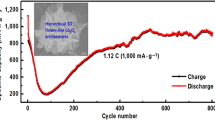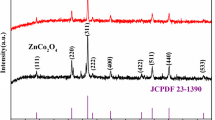Abstract
The flower-like Co3O4 particles with three-dimensional structure have been achieved by inheriting the flower-like framework of β-Co(OH)2 particles fabricated by a facile solvothermal method without any surfactant. The obtained Co3O4 microflower, which was composed of large amounts of self-assembled porous ultrathin nanosheets, exhibited excellent electrochemical performances in terms of high specific capacity and good cycle stability when being evaluated as anode materials for lithium-ion battery. Specifically, a high reversible capacity of above 1100 mA h g−1 was achieved after 50 cycles at the current density of 296 mA g−1. Hierarchical flower-like structure with mesoporous was considered as providing more active sites for Li+ insertion and paths for transport of Li+, which led to faster lithium-ion diffusion. Co3O4 porous flower-like nanostructures possessed significant potential application in energy storage systems.






Similar content being viewed by others
References
Tarascon JM, Armand M (2001) Issues and challenges facing rechargeable lithium batteries. Nature 414(6861):359–367
Armand M, Tarascon JM (2008) Building better batteries. Nature 451(7179):652–657
Wang J, Zhang Q, Li X, Xu D, Wang Z, Guo H, Zhang K (2014) Three-dimensional hierarchical Co3O4/CuO nanowire heterostructure arrays on nickel foam for high-performance lithium ion batteries. Nano Energy 6:19–26
Ding C, Zhao Y, Yan D, Zhao Y, Zhou H, Li J, Jin H (2016) An insight into the convenience and efficiency of the freeze-drying route to construct 3D graphene-based hybrids for lithium-ion batteries. Electrochim Acta 221:124–132
Zhao Y, Yan D, Ding C, Su D, Ge Y, Zhao Y, Zhou H, Li J, Jin H (2016) Fe2O3 nanocubes exposed (012) active facets combination with graphene rendering enhanced lithium storage capability. J Power Sources 327:658–665
Ding C, Yan D, Zhao Y, Zhao Y, Zhou H, Li J, Jin H (2016) A bubble-template approach for assembling Ni–Co oxide hollow microspheres with an enhanced electrochemical performance as an anode for lithium ion batteries. Phys Chem Chem Phys 18(37):25879–25886
Wu X, Wu W, Wang K, Chen W, He D (2015) Synthesis and electrochemical performance of flower-like MnCo2O4 as an anode material for sodium ion batteries. Mater Lett 147:85–87
Xia Y, Xiong Y, Lim B, Skrabalak S (2009) Shape-controlled synthesis of metal nanocrystals: simple chemistry meets complex physics. Angew Chem Int Ed 48(1):60–103
Fang D, Li L, Xu W, Li G, Li G, Wang N, Luo Z, Xu J, Liu L, Huang CL, Liang C (2013) Self-assembled hairy ball-like Co3O4 nanostructures for lithium ion batteries. J Mater Chem A 1:13203–13208
Kong D, Luo J, Wang Y, Ren W, Yu T, Luo Y, Yang Y, Cheng C (2014) Three-dimensional Co3O4@MnO2 hierarchical nanoneedle arrays: morphology control and electrochemical energy storag. Adv Funct Mater 24(24):3815–3826
Wang D, Wang Q, Wang T (2011) Morphology-controllable synthesis of cobalt oxalates and their conversion to mesoporous Co3O4 nanostructures for application in supercapacitors. Inorg Chem 50(14):6482–6492
Yan N, Hu L, Li Y, Wang Y, Zhong H, Hu X, Kong X, Chen Q (2012) Co3O4 nanocages for high-performance anode material in lithium-ion batteries. J Phys Chem C 116(12):7227–7235
Zhuo L, Wu Y, Ming J, Wang L, Yu Y, Zhang X, Zhao F (2013) Facile synthesis of a Co3O4–carbon nanotube composite and its superior performance as an anode material for Li-ion batteries. J Mater Chem A 1(4):1141–1147
Wang Z, Zhou L (2012) Metal oxide hollow nanostructures for lithium-ion batteries. Adv Mater 24(14):1903–1911
Yan C, Chen G, Zhou X, Sun J, Lv C (2016) Template-based engineering of carbon-doped Co3O4 hollow nanofibers as anode materials for lithium-ion batteries. Adv Funct Mater 26(9):1428–1436
Liu J, Kelly SJ, Epstein ES, Pan Z, Huang X, Liu J, Braun PV (2015) Three-dimensionally scaffolded Co3O4 nanosheet anodes with high rate performance. J Power Sources 299:40–48
Wang HW, Hu ZA, Chang YQ, Chen Y, Zhang Z, Yang Y, Wu H (2011) Preparation of reduced graphene oxide/cobalt oxide composites and their enhanced capacitive behaviors by homogeneous incorporation of reduced graphene oxide sheets in cobalt oxide matrix. Mater Chem Phys 130(1):672–679
Park JS, Cho JS, Kim JH, Choi YJ, Kang YC (2016) Electrochemical properties of micron-sized Co3O4 hollow powders consisting of size controlled hollow nanospheres. J Alloys Compd 689:554–563
Zhang XX, Xie QS, Yue GH, Zhang Y, Zhang XQ, Lu AL, Peng DL (2013) A novel hierarchical network-like Co3O4 anode material for lithium batteries. Electrochim Acta 111:746–754
Zhao Y, Li Y, Ma C, Shao Z (2016) Micro-/nano-structured hybrid of exfoliated graphite and Co3O4 nanoparticles as high-performance anode material for Li-ion batteries. Electrochim Acta 213:98–106
Lindström H, Södergren S, Solbrand A, Rensmo H, Hjelm J, Hagfeldt A, Lindquist S-T (1997) Li+ ion insertion in TiO2 (anatase). 2. Voltammetry on nanoporous films. J Phys Chem B 101(39):7717–7722
Lübke M, Shin J, Marchand P, Brett D, Shearing P, Liu Z, Darr JA (2015) Highly pseudocapacitive Nb-doped TiO2 high power anodes for lithium-ion batteries. J Mater Chem A 3:22908–22914
Lübke M, Sumboja A, Johnson ID, Brett D, Shearing P, Liu Z, Darr JA (2016) High power nano-Nb2O5 negative electrodes for lithium-ion batteries. Electrochim Acta 192:363–369
Pan L, Zhao H, Shen W, Dong X, Xu J (2013) Surfactant-assisted synthesis of a Co3O4/reduced graphene oxide composite as a superior anode material for Li-ion batteries. J Mater Chem A 1(24):7159–7166
Zhu X, Ning G, Ma X, Fan Z, Xu C, Gao J, Xu C, Wei F (2013) High density Co3O4 nanoparticles confined in a porous graphene nanomesh network driven by an electrochemical process: ultra-high capacity and rate performance for lithium ion batteries. J Mater Chem A 1(44):14023–14030
Wang Y, Yan F, Liu SW, Tan AYS, Song H, Sun XW, Yang HY (2013) Onion-like carbon matrix supported Co3O4 nanocomposites: a highly reversible anode material for lithium ion batteries with excellent cycling stability. J Mater Chem A 1(17):5212–5216
Wang J, Yang N, Tang H, Dong Z, Jin Q, Yang M, Kisailus D, Zhao H, Tang Z, Wang D (2013) Accurate control of multishelled Co3O4 hollow microspheres as high-performance anode materials in lithium-ion batteries. Angew Chem 125(25):6545–6548
Li H, Ma H, Yang M, Wang B, Shao H, Wang L, Yu R, Wang D (2017) Highly controlled synthesis of multi-shelled NiO hollow microspheres for enhanced lithium storage properties. Mater Res Bull 87:224–229
Zhang J, Ren H, Wang J, Qi J, Yu R, Wang D, Liu Y (2016) Engineering of multi-shelled SnO2 hollow microspheres for highly stable lithium-ion batteries. J Mater Chem A 4(45):17673–17677
Fan Y, Shao H, Wang J, Liu L, Zhang J, Cao C (2011) Synthesis of foam-like freestanding Co3O4 nanosheets with enhanced electrochemical activities. Chem Commun 47(12):3469–3471
Zhao Y, Xu X, Zhao Y, Zhou H, Li J, Jin H (2016) Synthesis and their physicochemical behaviors of flower-like Co3O4 microspheres. J Alloys Compd 654:523–528
Ding C, Su D, Ma W, Zhao Y, Yan D, Li J, Jin H (2017) Design of hierarchical CuS/graphene architectures with enhanced lithium storage capability. Appl Surf Sci 403:1–8
Xu X, Zhao Y, Li J, Jin H, Zhao Y, Zhou H (2015) Hydrothermal synthesis of cobalt particles with hierarchy structure and physicochemical properties. Mater Res Bull 72:7–12
Zhao Y, Zhang X, Wang C, Zhao Y, Zhou H, Li J, Jin H (2017) The synthesis of hierarchical nanostructured MoS2/Graphene composites with enhanced visible-light photo-degradation property. Appl Surf Sci 412:207–213
Acknowledgements
The authors gratefully acknowledge the financial support from the National Natural Science Foundation of China (Grant No. 51602023) and Beijing Institute of Technology Research Fund Program for Young Scholars.
Author information
Authors and Affiliations
Corresponding author
Rights and permissions
About this article
Cite this article
Zhai, X., Xu, X., Zhu, X. et al. Porous layer assembled hierarchical Co3O4 as anode materials for lithium-ion batteries. J Mater Sci 53, 1356–1364 (2018). https://doi.org/10.1007/s10853-017-1579-3
Received:
Accepted:
Published:
Issue Date:
DOI: https://doi.org/10.1007/s10853-017-1579-3




